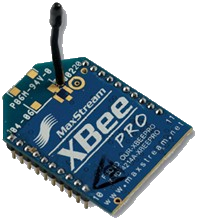
Zigbee is a form of wireless communication that is used in networks of small devices. The XBee radio allows devices to easily connect to a Zigbee mesh network.
The X-Bee technology kit was devised to allow makers ways to quickly bootstrap themselves on using Zigbee technologies. This kit provides makers with a bit of background information, an easy to follow tutorial, and all of the physical equipment necessary to implement the tutorial so that by the time the maker finishes going through the kit, they have a base knowledge of how wireless mesh network Zigbee works and how it is implemented.
This technology kit enables users to dabble in the world of XBee radios. XBee RF communication is a widely used technology that builds off of the Zigbee protocol. It is incredibly easy to get up-and-running and requires minimal knowledge in the field of communications. For this kit in particular, users are provided with everything they need in order to establish a communication channel using a Series 1 XBee module with a frequency of 2.4 GHz (XB24-AWI-001) between a host computer and a TI MSP430 microcontroller.
Implementation
Due to the timing of projects this semester, I happened to have completed this technology kit after Joe had already finished two of his own. This allowed me to base the structure of my kit off of the two that he had already established and borrow some of his code needed to configure using the built-in hardware UART on the MSP430. In fact, this was the trickiest part of designing the entire kit.
The XBee module used in this technology kit is designed to require almost no setup on the end of the user. All that one must do to use the module is to push information to send to the correct pin via a UART connection. As long as a module is powered up, any data that is sent via an additional module in range will automatically be picked up and can be read also via a UART connection. Therefore, because all of the actual protocol details are handled via the XBee, the only thing that must be established by the user is the UART communication to and from the module. This difficulty of configuration depends on the microcontroller selected.
While configuring the hardware UART on an MSP430 is not a trivial task, luckily for me Joe had already discovered how to correctly do this; one of his technology kits was solely focused on this task. I was able to take the code that he had already compiled and slightly modify it to use a few particular pins and enable interrupts for whenever a message was received. The XBee took care of the rest!
Organization
The kit will exist in a small container, accessible through the lab technician, Matt Lamparter. Inside the kit will exist the kit reference in hard copy, and all relevant physical materials needed (MSP430, USB cable, XBee modules, breadboard, wires, and portable USB charger). It will also exist in hard copy on the Maker-E Google Drive space here.
On the drive, each kit has its own directory. Inside this directory is the kit reference, and a resources folder. The resources folder will contain extra information like code (both partially completed and entirely completed code), supplementary instructions, and other general extra information.
Lessons Learned
One of the reasons for selecting an XBee kit was the foreseeable need to implement them in my senior design project. While we will not be using this exact model, developing this technology kit had provided me with a good background for the basics of using XBee modules. Once the kit was completed, I was able to test out the distance range for the communication. I found that the range is significantly limited when having to communicate indoors and through many of the intermittent obstacles within and around the Maker-E. Even though I did not get the chance to test the distance outdoors, I would assume that such a setting with a clear line-of-sight between modules would provide for much longer communication distance. This is an important point that my team will need to keep in mind when developing our senior design project.
Relevant Links